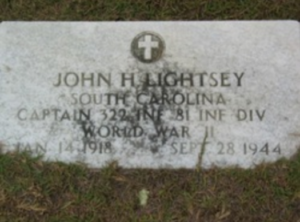Scroll of Honor – John Harold Lightsey ’40
A Speck in the Ocean
Written by: Kelly Durham
It’s just a speck on the map, a tiny dot of green contrasting with the blue expanse of the vast Pacific Ocean, but in 1944, the little island of Angaur’s location, north of New Guinea and east of the Philippines, made it valuable real estate. General Douglas MacArthur had promised to return to the Philippines and had convinced President Roosevelt to support his campaign for recapturing the islands from which he had so ignominiously been driven two and a half years earlier. MacArthur believed Angaur was an ideal site for the construction of an airfield from which land-based aircraft would be able to reach Japanese targets in the Philippines.
and east of the Philippines, made it valuable real estate. General Douglas MacArthur had promised to return to the Philippines and had convinced President Roosevelt to support his campaign for recapturing the islands from which he had so ignominiously been driven two and a half years earlier. MacArthur believed Angaur was an ideal site for the construction of an airfield from which land-based aircraft would be able to reach Japanese targets in the Philippines.
A sparsely-inhabited island in the Palau chain, Angaur is only three square miles in size, yet it was garrisoned by committed Japanese defenders.
While the 1st Marine Division attacked the neighboring and larger island of Peleliu, the Army’s 81st Infantry Division was ordered to capture Angaur. Among the officers of the 81st’s 322nd Regiment was Captain John Harold Lightsey, Clemson College Class of 1940.
Lightsey of Fairfax, had graduated from Clemson with a degree in agronomy and had been a member of the Animal Husbandry Club, the Literary Society and the Tiger newspaper staff. He had also served as vice-president of Kappa Alpha Sigma, the local chapter of the American Society of Agronomy. Lightsey remained a cadet private throughout his four years at Clemson.
Following graduation, Lightsey worked at the college for several months before securing employment as an agronomist with the Dixie Guano Company in Laurinburg, North Carolina. He was called to Army service in September 1941.
September 1944 found Lightsey waiting anxiously as the battleship Tennessee, accompanied by four cruisers and dozens of aircraft from the carrier Wasp, bombarded Angaur. After a delay caused by a shortage of landing craft, the 322nd Regimental Combat Team, including Captain Lightsey’s Company G, finally landed on Beach Red on the island’s northern side on September 17. At the same time, the 321st RCT landed on Beach Blue to the east side of the island. Although each RCT was counterattacked during the night, the American forces were able to link up the next day. By September 20, the Americans had forced the Japanese back to a position known as “The Bowl,” a hill into which the defenders had constructed fortified caves and from which they intended to make their last stand. Lightsey was wounded in this fighting.
battleship Tennessee, accompanied by four cruisers and dozens of aircraft from the carrier Wasp, bombarded Angaur. After a delay caused by a shortage of landing craft, the 322nd Regimental Combat Team, including Captain Lightsey’s Company G, finally landed on Beach Red on the island’s northern side on September 17. At the same time, the 321st RCT landed on Beach Blue to the east side of the island. Although each RCT was counterattacked during the night, the American forces were able to link up the next day. By September 20, the Americans had forced the Japanese back to a position known as “The Bowl,” a hill into which the defenders had constructed fortified caves and from which they intended to make their last stand. Lightsey was wounded in this fighting.
For a week, the 322nd repeatedly attacked the Bowl, but the Japanese hung on ferociously, firing back with artillery, mortars, machine guns and hand grenades. The defenders were gradually worn down by hunger, thirst and the relentless American shellfire and bombing. By the September 25, the Americans had penetrated the Bowl, but rather than continue to fight for every foot of bloody ground, the attackers called forward unconventional weapons: bulldozers. American combat engineers used the clanking machines to seal shut the entrances – and exits – to the caves. The battle dwindled to a series of small scale skirmishes, sniping, ambushing and booby-trapping. The last day of fighting was October 22. The Americans had finally taken the island, but – rare for the Pacific campaign – had suffered more casualties than they had inflicted. Among these was Captain John Lightsey who died on September 28.
Lightsey was awarded the Silver Star for his role in leading Company G during the attack. He was survived by his wife of less than two years, the former Janie Phillips of Cordele, Georgia and their two-month-old daughter Janice. In addition, Lightsey was survived by his parents, five sisters and three brothers, one of whom was serving not too far away on New Guinea. A fourth brother, Lieutenant Ralph Lightsey had been killed in an airplane crash the previous year.
Construction of airfields began even before the battle died out.  Still, the airfields weren’t completed in time to support the initial landings in the Philippines causing some, like 5th Fleet commander Admiral William F. Halsey, to question the necessity of the attack on the Palau Islands.
Still, the airfields weren’t completed in time to support the initial landings in the Philippines causing some, like 5th Fleet commander Admiral William F. Halsey, to question the necessity of the attack on the Palau Islands.
For more information about John Harold Lightsey visit:
https://soh.alumni.clemson.edu/scroll/john-harold-lightsey/
For additional information about Clemson University’s Scroll of Honor see:
https://soh.alumni.clemson.edu/
